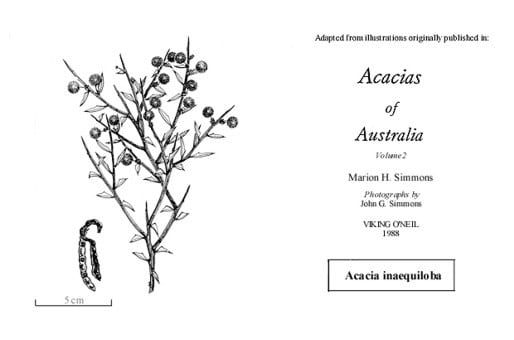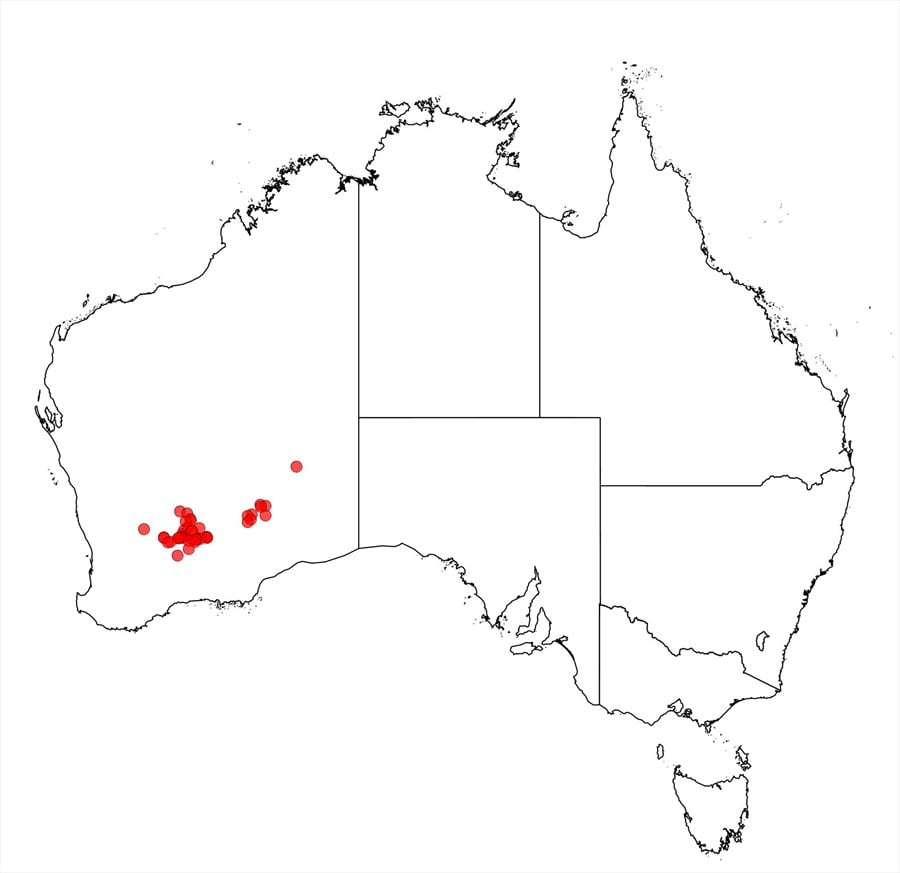Acacia inaequiloba W.Fitzg.
WATTLE
Acacias of Australia
Family
Fabaceae
Distribution
Occurs in the Southern Cross–Coolgardie and Queen Victoria Spring-Streich Mound (c. 200 km due ENE of Kalgoorlie) districts, W.A.
Description
Compact multistemmed shrub to 0.3 (–6) m high. Branchlets ±straight and erect, rigid, spinose, often pruinose, normally glabrous. Phyllodes variable, asymmetrically obtriangular to cuneate or very narrowly oblong-elliptic, with a prominent or inconspicuous gland-angle near or above middle of adaxial margin, 1–4.5 cm long, 2–10 mm wide, pungent, glaucous, normally glabrous; midrib near abaxial margin; lateral nerves obscure. Inflorescences 1 headed rudimentary racemes with axes to 1 mm long; peduncles normally 5–10 mm long, glabrous; basal bracts conspicuous, brown, somewhat persistent; heads globular to shortly obloid, 12–21-flowered, light golden to mid-golden; bracteoles caducous, conspicuous in buds. Flowers 5-merous; sepals irregularly united. Pods prominently rounded over seeds, undulate, to 7.5 cm long, 4–5 mm wide, thinly coriaceous–crustaceous, glabrous. Seeds longitudinally oblique, widely ovate-elliptic, obliquely truncate adjacent to aril, c. 3 mm long, shiny, mottled black and brown; aril conspicuous.
Specimens
W.A.: Queen Victoria Spring Nature Reserve, D.J.Pearson 230 (PERTH); 16 km NW of Bullabulling towards Caeynie Rock, B.R.Maslin 1889 (BRI, K, NSW, PERTH); 15 km by road S of Queen Victoria Rock, B.R.Maslin 5409 (MO, PERTH).
Notes
W.A.: Queen Victoria Spring Nature Reserve, D.J.Pearson 230 (PERTH).
W.A.: 16 km NW of Bullabulling towards Caeynie Rock, B.R.Maslin 1889 (BRI, K, NSW, PERTH); 15 km by road S of Queen Victoria Rock, B.R.Maslin 5409 (MO, PERTH).
Two geographically disjunct variants are recognised and future studies may show that each should be afforded a formal rank.
The species is probably related to A. nigripilosa.
The second variant has phyllodes that are asymmetrically obtriangular to cuneate, with conspicuous gland-angle, 10–35 mm long, 3–10 mm wide, l:w = 1.5–6. It is found in the Coolgardie–Southern Cross area, and grows in yellow sand in open scrub, often with mallee eucalypts.
The first variant has phyllodes that are very narrowly oblong-elliptic, with inconspicuous gland-angle, 15–45 mm long, 2–3 mm wide, l:w = 9–20. It is found in the Queen Victoria Spring–Streich Mound area, and grows in red sand with Eucalyptus youngiana over spinifex (Triodia spp.). This uncommon variant includes the type of the species; it resembles A. scleroclada in general appearance.
FOA Reference
Data derived from Flora of Australia Volumes 11A (2001), 11B (2001) and 12 (1998), products of ABRS, ©Commonwealth of Australia
Author
B.R.Maslin
This identification key and fact sheets are available as a mobile application:
URL: https://apps.lucidcentral.org/wattle/
© Copyright 2018. All rights reserved.










